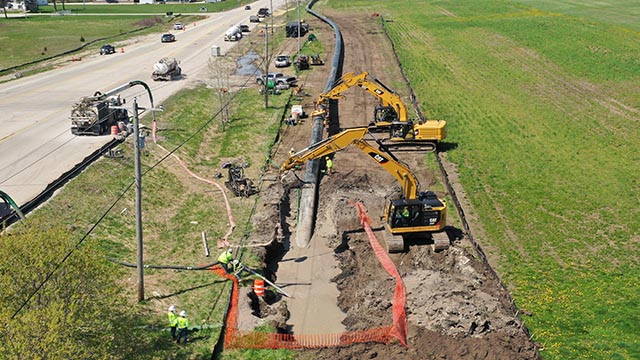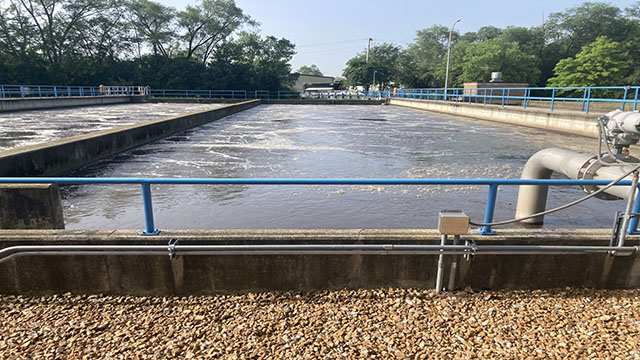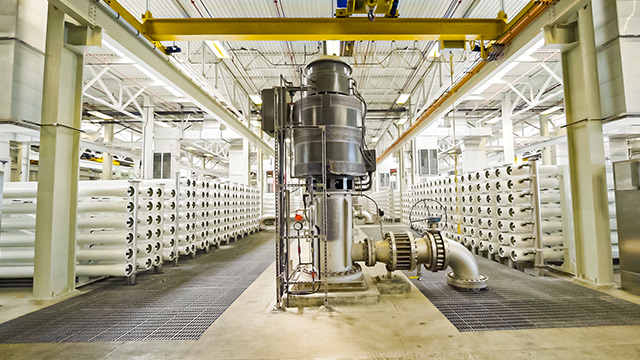Serving over 3.6 million customers, Toronto Water is one of the largest municipal water, wastewater and stormwater utilities in North America. Toronto Water’s Humber Treatment Plant is located at the mouth of the Humber River in Etobicoke, a suburb west of downtown Toronto. This plant is Toronto’s second largest wastewater treatment facility, serving a population of approximately 662,000. As part of Toronto’s large-scale Capital Improvements Program (CIP), the Humber Treatment Plant - South Plant required upgrades to address aging infrastructure and buildings, optimize operational performance, and address community concerns.
Strategically Planned Construction Ensured Uninterrupted Operations
Toronto Water was looking for a supplier with global wastewater treatment resources and experience with engineering and construction for tight urban spaces. Black & Veatch was selected to work with the City of Toronto’s Engineering & Construction Services (ECS) division and provide detailed design, program management, and construction management services for the South Plant upgrades. During the design phase, Black & Veatch determined that only one process train (comprising of one aeration tank and four final clarifiers) could be taken out of service at any given time to maintain existing facility operations throughout construction. The team performed multiple constructability reviews to develop a feasible sequencing plan, avoiding operational disruptions and ensuring compliance with effluent discharge requirements set by the Ministry of the Environment, Conservation and Parks (MECP). City of Toronto ECS and Black & Veatch in conjunction with Toronto Water fostered a collaborative owner/contractor relationship through effective communication and regular team-building meetings.
Modernizations Improve Performance, Safety, and Aesthetics
Updates to the Humber Treatment South Plant included aeration tank modernizations, ferrous chloride feed system replacements, a new Return Activated Sludge (RAS) building, final clarifiers enhancements, electrical substation upgrades, and a new effluent pumping station. Additional CIP scope details are as follows:
Aeration tank modernizations. The aeration tank upgrades included an anoxic zone, new air headers, replacement of diffusers and diffuser grid piping, and new access hatches and precast concrete covers. Two baffle/weir walls were added to the first pass of each aeration tank to separate the new anoxic zone (where oxygen is depleted) from the aerated zones. The anoxic zone saves energy by utilizing four mechanical mixers powered by two horsepower motors and runs 24/7; the alternative option was to use process air, which would have required massive and inefficient blowers. The four mechanical mixers to combine the primary effluent and the incoming RAS, and membrane air diffusers were added as a redundancy. Previously, the piping used to carry the process air from the blower building to the aeration tanks was routed inside the tunnel galleries. As part of the aeration tank modernizations, a new main South Plant air header was constructed above the tunnel, allowing safer and more convenient access to the lower level for equipment maintenance and repairs.
Ferrous chloride feed system replacements. It was discovered that the South Plant was injecting excess ferrous into the system due to outdated aerating operations and broken piping in the diffuser grids. Upgrades to the ferrous chloride feed system replaced the storage tanks, pumps and feed piping throughout the plant. These upgrades allow the ferrous chloride to disperse more effectively, resulting in a drop in ferrous demand by more than 30%.
New RAS building. The original plant featured an odour control system that was used to treat the air from the mixed liquor discharge. Originally built in the 1970s, this system was known as the “Green Monster” for its unappealing appearance. It was removed to accommodate the architectural continuity of the new RAS building extension. The old RAS and WAS pumps in the existing RAS building were replaced with the new pumps in the building extension while glycol skid, cross-feed, and drain pumps were installed in the existing building.
Final clarifiers enhancements. Because the existing clarifier required a constant spray of water to push scum through slots in the center well, an Energy Dissipating Inlet (EDI) was installed to evenly disperse the influent and effectively separate the scum and sludge. Density currents sometimes form at the bottom of the clarifier tank above the sludge blanket and can deposit solids in the effluent troughs. To mitigate this, a density current baffle (also known as a Stamford baffle) was added to the perimeter of each final clarifier tank. The density current baffle is essentially a fiberglass projection that redirects the density currents back towards the center to improve performance and prevent effluent contamination.
Proactively Mitigating Flood Dangers
Like most CIPs in major cities, the Humber Treatment Plant upgrades came with numerous challenges that the team had to overcome. In Tunnel Gallery T19, an existing pipe that collected effluent from the final clarifiers needed to be removed to make space for a new scum tank. The effluent conduit discharged to an outfall to Lake Ontario; since it was located below lake level, the galleries were in danger of flooding if the pipe was ever breached. To protect the pipe and proactively reduce the risk of flooding, the team cut an opening into the effluent conduit and sent a professional diver to insert a plug and install a plate with a gasket. From the tunnel side, a plate was welded on and the pipe was filled with grout and encased flush to the wall.
With substantial completion achieved in November 2022, the modernized Humber Treatment Plant handles 125 million gallons per day (473 million liters per day) to keep up with Toronto’s rapidly growing population. Construction was strategically sequenced to mitigate any disruptions to facility operations. These upgrades create safer conditions for utility staff, ensure reliability of wastewater treatment processes, and maintain the beautiful City of Toronto landscape.








